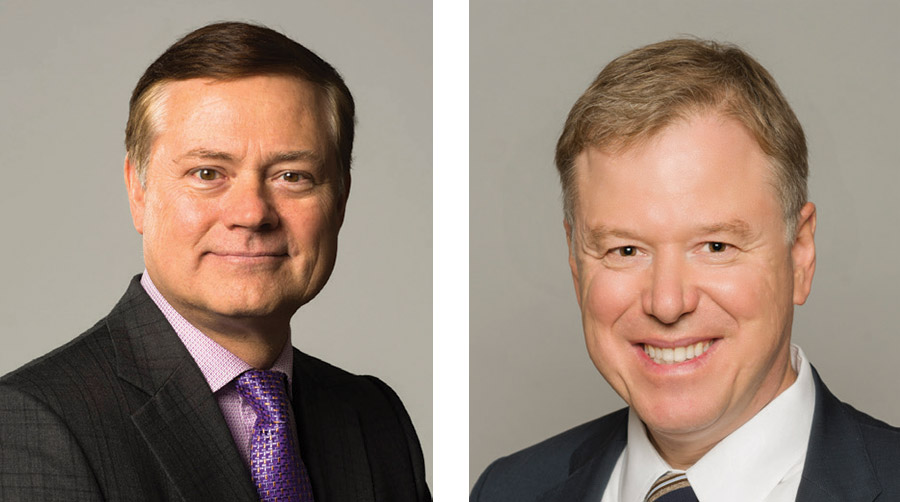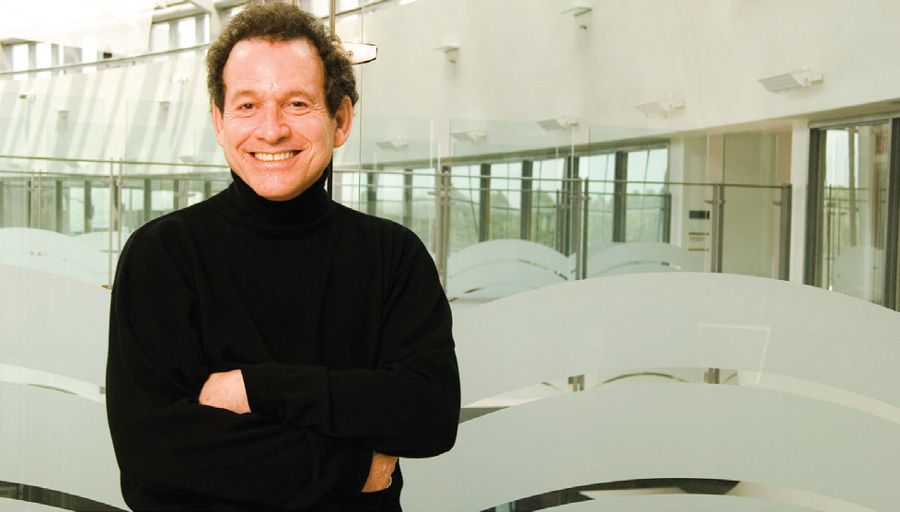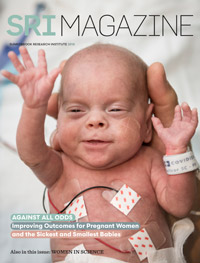
Messages
Getting discoveries to people

Blake Goldring (left) and Dr. Andy Smith (right)
Photos: Doug Nicholson
In 2018, Sunnybrook unveiled its new three-year Strategic Plan. It affirms our commitment to innovation, education and excellent care, and details how we will achieve strategic directions that honour and advance our vital role in the health care system. Ultimately, we seek to provide the best care to the most critically ill and injured patients.
This highly complex care comes to life through the dedication of our teams, as well as inventive research. The strategic direction Personalized and Precise Treatments captures how we are creating and using novel technologies to prevent and diagnose disease, and deliver precise treatments where few or no options exist.
One of the strongest examples comes from a research team who this year used focused ultrasound to open the blood-brain barrier in people with Alzheimer’s disease. These landmark results inch us closer to the team’s vision of being able to deliver therapies directly to the brain to treat diseases now deemed untreatable. Read more about this research.
Also in this issue is a panorama of the tireless work of the DAN Women & Babies Program. In finding new ways to care for women facing challenging pregnancies and creating best practices for babies born too early, all while saving lives along the way, these researchers are driven to rewrite the care manual for high-risk pregnancies and preterm birth or, better yet, prevent them from happening in the first place.
At the heart of it all remains collaboration, not only among teams internally and throughout the province, but also with the community—our patients and their families—supported by indispensable investment from our funding partners and philanthropic champions. Thank you all for helping us to invent tomorrow’s health care.
Blake Goldring
Chair, Board of Directors
Sunnybrook Health Sciences Centre
Andy Smith
President and CEO
Sunnybrook Health Sciences Centre

Dr. Michael Julius
Photo: Doug Nicholson
As a hospital-based research institute, making discoveries and getting them to our patients, and beyond, impels all that we do. Daily, Sunnybrook Research Institute (SRI) scientists and their teams work to close in on clinical impact.
A look back over the last year, captured in part by the stories in this year’s magazine, shows they are gaining ground. The translational research of the DAN Women & Babies Program is without parallel, pushing ahead to define and deliver personalized care, and help the most vulnerable babies live and thrive. Earlier this year, led by Dr. Jon Barrett, the program established the Alliance, a massive, province-wide initiative to get knowledge out of its creators’ hands and into the real world, where it can prevent preterm birth and save lives on a scale not seen before.
This past year witnessed extraordinary achievement in other urgent-need domains, too. Focused ultrasound, a promising new approach for Alzheimer’s disease, passed with flying colours its first clinical test, in a global first. A hand-held device showed that it could be used to print skin to treat burns. A noninvasive imaging technique distinguished benign from malignant tumours in breast cancer, without the need for needle biopsy. Remarkable, all, with many more, besides. Increasingly, our focus will turn to working with the province to streamline adoption of such discoveries into the health care system—an end-to-end solution.
This past year also saw many conversations about gender equity and diversity bubble up. Agencies like the Canadian Institutes of Health Research, the largest for such research, and the Canada Research Chairs Program, are tackling them head-on. Our features on women in science contribute to this conversation, by sharing the thoughts and experiences of successful female scientists at SRI, along with those of the generation coming up behind them.
Enjoy!
Michael Julius
Vice-President, Research
Sunnybrook Research Institute & Sunnybrook Health Sciences Centre
Professor, Departments of Immunology & Medical Biophysics
Faculty of Medicine, University of Toronto



